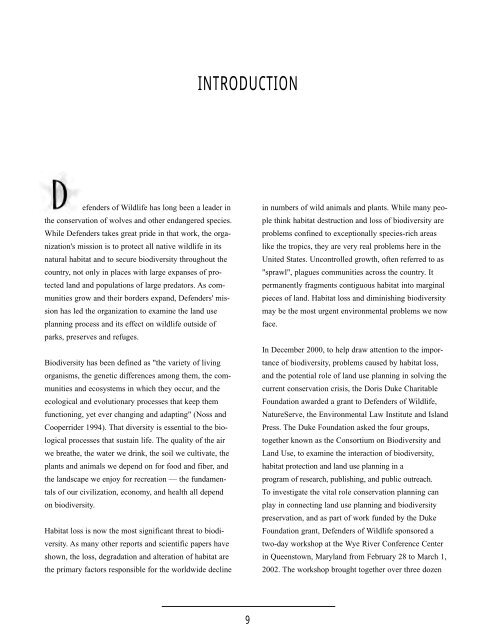Integrating Land Use Planning and Biodiversity - Defenders of Wildlife
Integrating Land Use Planning and Biodiversity - Defenders of Wildlife
Integrating Land Use Planning and Biodiversity - Defenders of Wildlife
You also want an ePaper? Increase the reach of your titles
YUMPU automatically turns print PDFs into web optimized ePapers that Google loves.
INTRODUCTION<br />
efenders <strong>of</strong> <strong>Wildlife</strong> has long been a leader in<br />
the conservation <strong>of</strong> wolves <strong>and</strong> other endangered species.<br />
While <strong>Defenders</strong> takes great pride in that work, the organization's<br />
mission is to protect all native wildlife in its<br />
natural habitat <strong>and</strong> to secure biodiversity throughout the<br />
country, not only in places with large expanses <strong>of</strong> protected<br />
l<strong>and</strong> <strong>and</strong> populations <strong>of</strong> large predators. As communities<br />
grow <strong>and</strong> their borders exp<strong>and</strong>, <strong>Defenders</strong>' mission<br />
has led the organization to examine the l<strong>and</strong> use<br />
planning process <strong>and</strong> its effect on wildlife outside <strong>of</strong><br />
parks, preserves <strong>and</strong> refuges.<br />
<strong>Biodiversity</strong> has been defined as "the variety <strong>of</strong> living<br />
organisms, the genetic differences among them, the communities<br />
<strong>and</strong> ecosystems in which they occur, <strong>and</strong> the<br />
ecological <strong>and</strong> evolutionary processes that keep them<br />
functioning, yet ever changing <strong>and</strong> adapting" (Noss <strong>and</strong><br />
Cooperrider 1994). That diversity is essential to the biological<br />
processes that sustain life. The quality <strong>of</strong> the air<br />
we breathe, the water we drink, the soil we cultivate, the<br />
plants <strong>and</strong> animals we depend on for food <strong>and</strong> fiber, <strong>and</strong><br />
the l<strong>and</strong>scape we enjoy for recreation — the fundamentals<br />
<strong>of</strong> our civilization, economy, <strong>and</strong> health all depend<br />
on biodiversity.<br />
Habitat loss is now the most significant threat to biodiversity.<br />
As many other reports <strong>and</strong> scientific papers have<br />
shown, the loss, degradation <strong>and</strong> alteration <strong>of</strong> habitat are<br />
the primary factors responsible for the worldwide decline<br />
in numbers <strong>of</strong> wild animals <strong>and</strong> plants. While many people<br />
think habitat destruction <strong>and</strong> loss <strong>of</strong> biodiversity are<br />
problems confined to exceptionally species-rich areas<br />
like the tropics, they are very real problems here in the<br />
United States. Uncontrolled growth, <strong>of</strong>ten referred to as<br />
"sprawl", plagues communities across the country. It<br />
permanently fragments contiguous habitat into marginal<br />
pieces <strong>of</strong> l<strong>and</strong>. Habitat loss <strong>and</strong> diminishing biodiversity<br />
may be the most urgent environmental problems we now<br />
face.<br />
In December 2000, to help draw attention to the importance<br />
<strong>of</strong> biodiversity, problems caused by habitat loss,<br />
<strong>and</strong> the potential role <strong>of</strong> l<strong>and</strong> use planning in solving the<br />
current conservation crisis, the Doris Duke Charitable<br />
Foundation awarded a grant to <strong>Defenders</strong> <strong>of</strong> <strong>Wildlife</strong>,<br />
NatureServe, the Environmental Law Institute <strong>and</strong> Isl<strong>and</strong><br />
Press. The Duke Foundation asked the four groups,<br />
together known as the Consortium on <strong>Biodiversity</strong> <strong>and</strong><br />
<strong>L<strong>and</strong></strong> <strong>Use</strong>, to examine the interaction <strong>of</strong> biodiversity,<br />
habitat protection <strong>and</strong> l<strong>and</strong> use planning in a<br />
program <strong>of</strong> research, publishing, <strong>and</strong> public outreach.<br />
To investigate the vital role conservation planning can<br />
play in connecting l<strong>and</strong> use planning <strong>and</strong> biodiversity<br />
preservation, <strong>and</strong> as part <strong>of</strong> work funded by the Duke<br />
Foundation grant, <strong>Defenders</strong> <strong>of</strong> <strong>Wildlife</strong> sponsored a<br />
two-day workshop at the Wye River Conference Center<br />
in Queenstown, Maryl<strong>and</strong> from February 28 to March 1,<br />
2002. The workshop brought together over three dozen<br />
9
















![[PDF] Community Development Toolkit - CommDev](https://img.yumpu.com/48616495/1/184x260/pdf-community-development-toolkit-commdev.jpg?quality=85)
